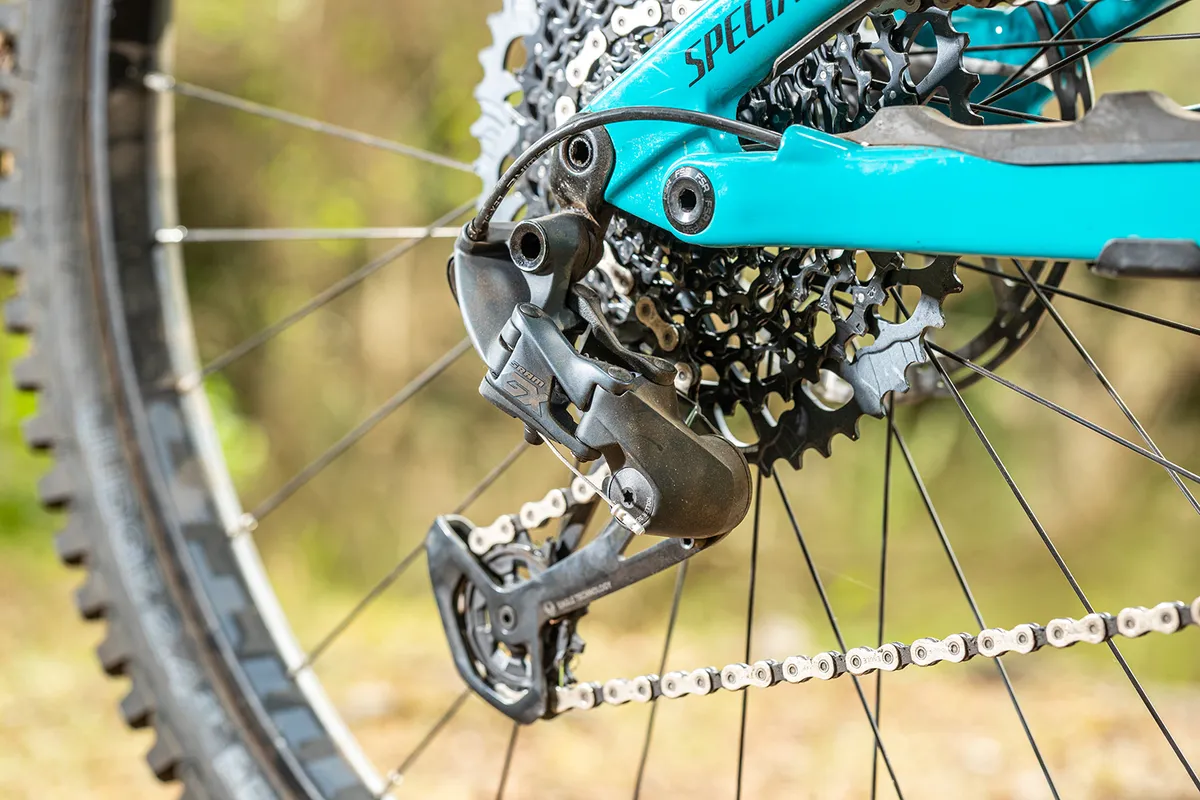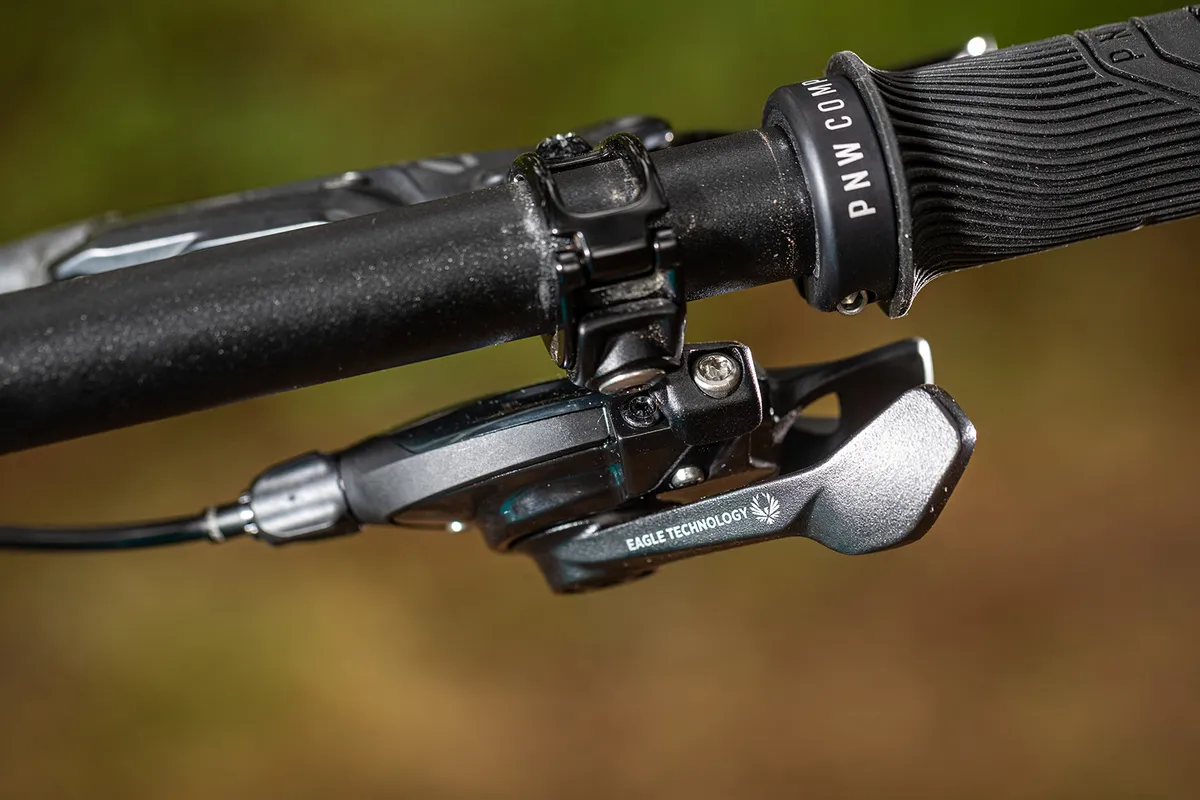Jaws dropped when SRAM first launched its whopping 12-speed Eagle cassette back in 2016, mainly thanks to the sheer size of the 50t largest cog.
Since then, the sight of those dinner plate-sized cassettes has become common place and it seems most bike brands won’t let a bike out of their factory doors if it doesn’t boast a 500 per cent gear range.
- Mountain bike groupsets: everything you need to know
- TRP wants a slice of the 12-speed pie with new TR12 drivetrain
But then, Shimano launched its 12-speed offering, which upped the ante and the gear range thanks to the extra tooth on its 10-51t cassette and its 510 per cent range.
After a year or two of having the upper hand, or at least, the wider spread of gears, SRAM’s new, even wider range cassette (520 per cent) could put it firmly back in the lead.
Five things you need to know about SRAM’s new Eagle 10-52t cassette
- The 10-52t cassette provides a massive 520 per cent gear range
- SRAM has updated its GX, X01 and XX1 derailleurs to work with the new cassette (the AXS Eagle derailleur is already designed to work with a 52t cog)
- The gear steps from the 10t to the 42t cogs remain the same as on the original Eagle cassette (it then jumps from the 42t to the 52t, rather than the 50t)
- First generation Eagle derailleurs won’t work with the new 10-52t cassette
- The 10-50t cassette is still available and will work with the new derailleurs
SRAM Eagle 12-speed 10-52-tooth cassette details

SRAM’s new 10-52t cassette will be offered on the freshly overhauled GX, X01 and XX1 Eagle drivetrains, but not on the cheaper NX or SX range just yet.
As with its 10-50t cassette (which is still available and likely to be the choice of the professional cross-country racer), this new unit fits onto SRAM's XD Driver freehub body, and, as I’ve mentioned already, has 12 cogs.
It also has almost identical steps between the gears as the 10-50t, although the new, wider range cassette has a bigger 10t jump from the 42t to the 52t cog.
The jump from the 42t to the 50t cog equates to a 19 per cent jump, while shifting from the 42t to the 52t cog on the latest cassette increases this to a 23.8 per cent jump. Lower down the block (from the 10-42t cogs), the steps remain the same (10, 12, 14, 16, 18, 21, 24, 28, 32, 36, 42, 52t).
But why make a 52t sprocket? Was it all about getting one up on rivals, Shimano? Well, no, not really. It seems it’s just a happy coincidence.
SRAM’s Alex Rafferty explains: “because of cassette architecture and X-Sync technology (the alternate narrow-wide tooth profiling) on the largest cog, it’s only possible to increase by multiples of two.”
And what prompted making it in the first place? Surely, just as we heard back in 2016, a 50t cog was more than enough.
Rafferty says: “think of your favourite enduro race. You want to be able to spin up the hills a little easier and still be fast when you need to be fast. Nobody wants to push. We design and innovate the products that we believe are the best and most appropriate for the rider at the present time and in the near future.
"The development of SRAM 1x drivetrains is a product of engineering that we understand as the rider’s needs, and what we believe they will want in the future. We knew there was scope to increase the range and benefit to our cassette offerings.”
And why not even out those steps between gears, just as Shimano’s cassette does?
Alex tells us that “expanding the range to a 52t is a small step in the design process, allowing us to incrementally improve your experience as we perfect our ideas. If gear step percentage is something that concerns you, our proven 10-50t cassette is still offered.”
SRAM Eagle 12-speed 10-52-tooth cassette construction
There are currently three new Eagle cassettes available. Along with the top tier XX1 cassette (XG-1299) there’s also the X01 (XG-1295) and the GX (XG-1275) unit I’ve been riding.
All of these cassettes use the same largest 52t alloy cog, but the construction of the XX1 and X01 cassettes differs greatly from the GX cassette.
Both the XX1 and X01 cassette use SRAM’s X-DOME technology. This means that, in a bid to keep them as light as possible, 11 of the 12 cogs are machined out of a single piece of case hardened steel. This, as you’d expect, makes them more expensive too.
The more affordable GX cassette on the other hand uses the brand’s FULL-PINNED design. This means stamped steep cogs are, you guessed it, pinned together, creating a very similar hollow structure inside the cassette as on its pricier equivalents.
SRAM claims this is good for saving weight and ensures it’s still really durable, telling us: “there is however more material used on the GX cassette in the design process, that along with the number of pins holding it together adds a little bit of weight but also reduces the cost to the rider”.
SRAM Eagle 12-speed 10-52-tooth cassette compatibility
Before you ask, no, you can’t just go out and buy this new 10-52t cassette in the hope that it'll work with your existing Eagle derailleur. Unless of course you’re lucky enough to own the electronic, wireless AXS rear derailleur, which was designed to work with a 52t cog from the get-go.
Unfortunately for those with first generation Eagle derailleurs, SRAM says it can’t confidently recommend making the switch to the new cassette because shift performance would be compromised. The new rear derailleurs (which I’ll talk about shortly) have all been altered to accommodate the shift up to the bigger 52t cog.
That means, unless you already own an AXS derailleur, you’ll need to shell out for an updated Eagle unit if you want to use this new, wider range cassette.
SRAM Eagle 12-speed 10-52-tooth rear derailleur updates

To accommodate the new 52t cog, SRAM had to tweak the current Eagle derailleur to ensure it shifted smoothly and could handle the 10t jump between the two largest cogs.
SRAM says that by implementing the changes it had designed into the AXS Eagle derailleur, it was not only able to make things work with the larger sprocket, but also improve overall chain management.
What does that mean, though?
If you cast your minds back to our Eagle AXS derailleur review, you’ll remember the AXS derailleur uses a different pulley wheel offset, a shorter cage and a lengthened parallelogram.
This, according to SRAM, helps to create more chain wrap – something that helps to improve cassette life because the chain is in contact with more teeth on a given cog, and therefore lessens the load on each tooth – along with improving its position for shifting.
Coupled with a new spring and pivot hardware, SRAM claims improved shifting across the entire gear range.
As a consequence of this, SRAM has created a new chain gap tool to aid with setting the b-tension screw (which controls the spacing between the upper pulley and the bottom of the cassette) adjustment.
This new tool – which is used on the 42t cog and when the bike (if it’s a full-suspension design) is at sag – will work across all 12-speed Eagle systems and is easy to use.
Updates to SRAM GX, X01 and XX1 Eagle cranksets

While the new cassette is the headline news here, with the revised rear derailleur coming in a close second, SRAM has also rolled out a number of other updates to its Eagle transmissions.
The focus from the US brand is very much on the cheapest of the three, GX Eagle. In fact, this was the one it sent to me, so I could get some miles in prior to it actually being launched.
While there is a new carbon GX Eagle crankset (which the brand says uses proprietary carbon layup technology), I received the alloy version, which SRAM claims to be “the best aluminium crankset we make”.
It weighs 657g, complete with the 32t X-Sync 2 chainring. Look closely and you’ll spot that the ring’s narrow-wide teeth are now silver, rather than black.
SRAM has put these through a two-tone anodisation process (a wear-resistant treatment to better improve durability), and simply decided the silver teeth looked cooler than black, which is fair enough.
The whole GX Eagle groupset now comes in SRAM’s Lunar colourway and weighs a total of 1,906g (including cassette, shifter with cable, chain, derailleur, DUB bottom bracket and crankset).
While the shifter remains the same as the previous GX offering, there is now a single click option aimed at e-MTB users.
Like GX Eagle, X01 and XX1 Eagle have also had a makeover (wider range cassettes and compatible derailleurs, along with the updated chainring treatments), but the rest of the componentry stays much the same.

The X01 drivetrain is now available in Lunar Black or Oxy Red while the flagship XX1 Eagle now includes a copper, gold or rainbow colour option for the cassette and black, gold, copper or rainbow options for the chain.
2020 SRAM GX Eagle groupset pricing
Pricing for the new GX Eagle transmission starts at £495 / $545 / €555.
2020 SRAM GX Eagle groupset first ride impressions

I’ve only had a handful of rides on the new GX Eagle transmission and, so far, it’s performing well.
While the gear steps from the 42t cog down haven’t changed and feel exactly the same as on the 10-50t cassette GX cassette this replaces, I was really intrigued to see how the shift up into the new 52t cog would feel.
As you can imagine, I only ever shifted into the largest cog when the trail became hideously steep. At this point, I found that as I was already travelling so slowly and turning the cranks quite slowly, the shift from the 42t to the 52t never felt problematic or like such a dramatic change in cadence that I would instantly spin out.
It felt like a natural progression when I really needed it. Thankfully, the shift is relatively smooth too, even under power, and hasn’t yet felt laboured or strained (I’ve had similar experience when trying the bigger cassette with the AXS Eagle setup too).
It’s when speed picks up or the trail begins to level off and you shift from the largest 52t to the 42t cog that you really notice that 10t jump.
I found that once I’d started to spin the 52t gear a little too easily and had shifted into the 42t cog, the change to my pedalling rhythm felt more disrupted due to the sizable step between gears.
It’s not the smoothest under power either and requires a little finesse when making the shift.
That said, the new 52t cog is essentially a bailout gear, designed for steep pitches where you otherwise might get off your bike and push. And in those instances, it does a very effective job of giving you a wider range of gearing and a better chance of getting up the climb on the bike.
I’ll be doing a full review of the new GX Eagle gearing over the coming months, so keep an eye out for that here.
